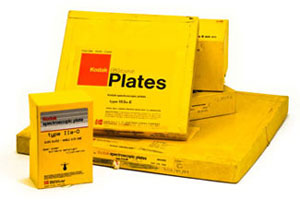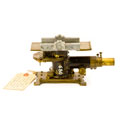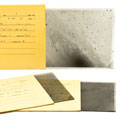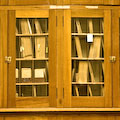

 By the first decade of the twentieth century, the photographic plate had become the dominant
detector in observational astronomy. New telescopes were conceived as cameras and designed for
photography, older ones adapted for taking pictures. No large professional observatory was without
a photographic capability, and astronomers became proficient darkroom technicians.
In the years that followed, millions of plates were exposed at observatories all over the world,
tens of thousands of them by Lick astronomers using a long succession of cameras and spectrographs.
The principal telescopes of Lick's early years—the 36-inch refractor, its 12-inch cousin, and
the Crossley reflector—had been built during the last hurrah of visual observing, but were now
mainly used for photography. The major additions of later years—the 20-inch dual astrograph
and the Shane 120-inch reflector—were photographic telescopes from the outset, their eyepieces
serving only to acquire targets and guide exposures.
Photography's long reign lasted until the arrival of digital imaging in the early 1980s.
However, it was increasingly sharing the stage with a variety of electronic detectors that, at Lick,
had begun appearing as early as the 1910s. Part II of From Eyeballs to Electrons will
tell the story of their development and, finally, of the digital revolution in astronomy.
Note: When discussing the history of astronomy after the discovery of celestial radio waves in the
early 1930s, it becomes necesssary to make the distinction between optical observations and those
made at other wavelengths. From Eyeballs to Electrons is concerned with the detectors used in
optical astronomy.
Learn more.
By the first decade of the twentieth century, the photographic plate had become the dominant
detector in observational astronomy. New telescopes were conceived as cameras and designed for
photography, older ones adapted for taking pictures. No large professional observatory was without
a photographic capability, and astronomers became proficient darkroom technicians.
In the years that followed, millions of plates were exposed at observatories all over the world,
tens of thousands of them by Lick astronomers using a long succession of cameras and spectrographs.
The principal telescopes of Lick's early years—the 36-inch refractor, its 12-inch cousin, and
the Crossley reflector—had been built during the last hurrah of visual observing, but were now
mainly used for photography. The major additions of later years—the 20-inch dual astrograph
and the Shane 120-inch reflector—were photographic telescopes from the outset, their eyepieces
serving only to acquire targets and guide exposures.
Photography's long reign lasted until the arrival of digital imaging in the early 1980s.
However, it was increasingly sharing the stage with a variety of electronic detectors that, at Lick,
had begun appearing as early as the 1910s. Part II of From Eyeballs to Electrons will
tell the story of their development and, finally, of the digital revolution in astronomy.
Note: When discussing the history of astronomy after the discovery of celestial radio waves in the
early 1930s, it becomes necesssary to make the distinction between optical observations and those
made at other wavelengths. From Eyeballs to Electrons is concerned with the detectors used in
optical astronomy.
Learn more.
Click on the thumbnails below for more on astrophotography at Lick Observatroy in the twentieth century.
 Dual Astrograph
Dual Astrograph
 Planetary camera
Planetary camera
 Astrometric camera
Astrometric camera
 120-inch plates
120-inch plates
 Plate Vault
Plate Vault
